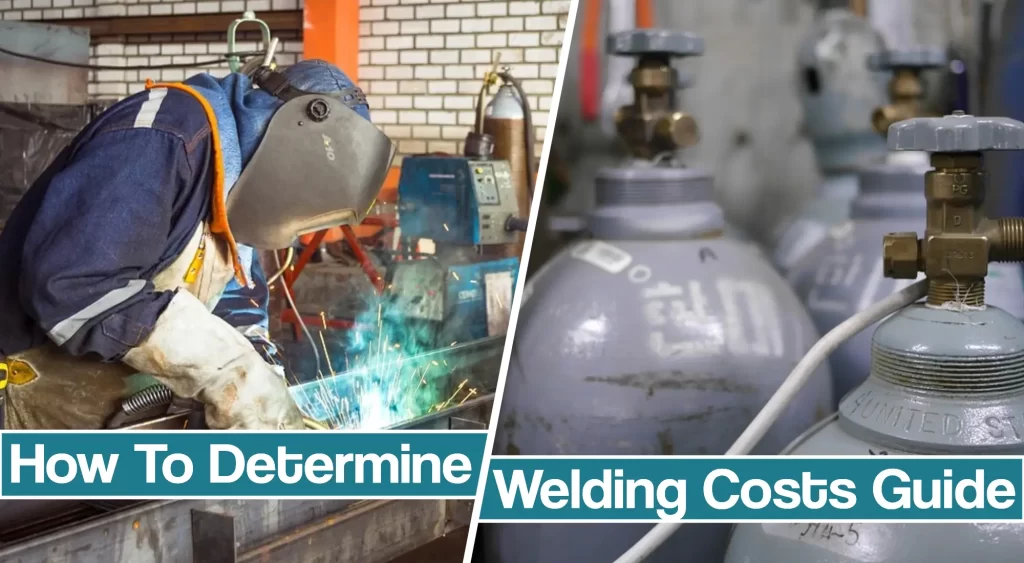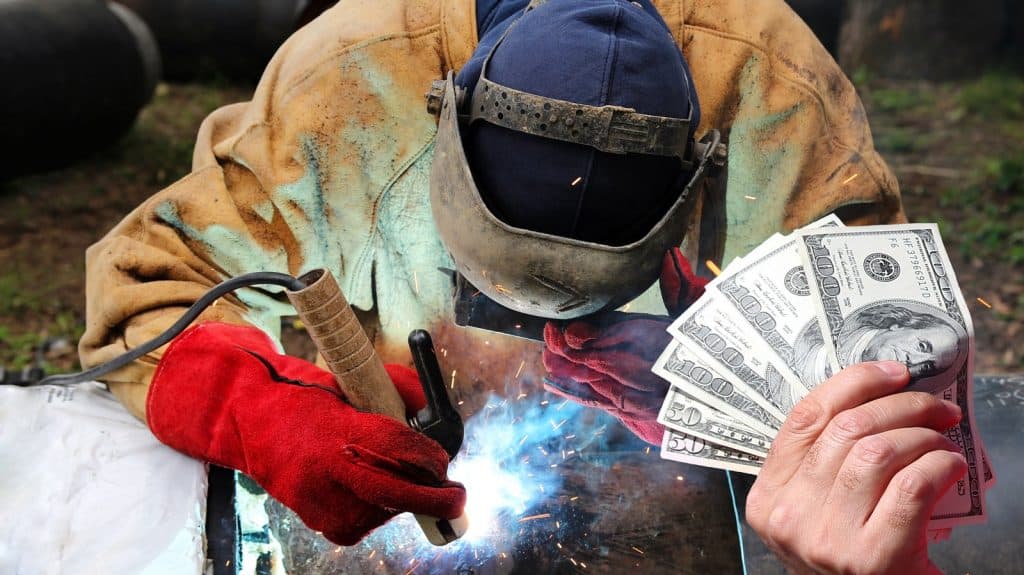When it comes to welding, most manufacturers lack an understanding of how much they are spending, what they are spending it on, or why. However, even though welding is known as expensive labor, there are simple ways to determine the costs.
Once you comprehend welding economics and values, you will be able to compete in the market. In addition, you should know to value your hard work.

This article will help you in determining the cost of welding, which can lead you to increased competitiveness and profit.
Is Determining the Cost of the Welding Necessary?
Determining the costs of your welding application is not essential, but once you understand it, you can reduce the costs and increase productivity, profitability, and competitiveness. For example, achieving the same results using the welding process with higher productivity will impact the final costs.
If you manage to implement a cost-effective model, you can estimate the savings. Another example is automation, where initial investments might be higher, but you will quickly pay off the capital investment when you calculate the costs of welding.
What Factors Affect Welding Costs?
In reality, every operation related to welding can be legitimately charged to weld fabrication. In addition, the more factors you consider will give you the more accurate results. However, you have to ask first if the cost is actually comparative to the welding operation.
The more factors you can consider, the higher are chances you can reduce the overall costs. But, what are the factors that affect welding costs? The list isn’t concise, but the more you consider, the more accurate results you will get. We can separate it into two parts – actual costs and time for an operation.
Costs:
- Costs associated with any required stress relief.
- Cost of electrodes.
- Cost of shielding materials.
- Cost of electric power.
- Cost of fuel gas for preheating (when needed).
Time:
- Time for joint preparation.
- Time to prepare the material for welding (blasting, removal of oils, etc.).
- Time for assembly.
- Time to preheat the joint (when needed).
- Time for tack-up.
- Time for positioning.
- Time for welding.
- Time to remove slag (when applicable).
- Time to remove spatter.
- Time for inspection.
- Time for changing electrodes.
- Time to move the welder from one location to another.
- Time to shift welding machine settings.
- Time spent by personnel for personal purposes.
- Time to repair or rework defective welds.
As you can deduce from the list, time should be accounted for the more significant part of the costs. However, fees will be predominant when dealing with unusually expensive materials or requiring high skill.
Calculating the Welding Costs – Different Methods
Once you decide to determine the welding costs, you can take several different methods. You can either choose a complex or straightforward approach.
Of course, each method has its good and bad sides, but you can quickly choose what’s works out best for you. For example, computer-based methods are complex but more precise. However, with a simplified approach, you can calculate the costs yourself.

To help you understand and calculate welding costs, we will explain the simplified approach. This method uses labor and overhead (L/O) and the cost of welding consumables and shielding materials to calculate the costs.
Several different factors can affect the costs of labor and overhead. However, overhead factors, including plant and equipment, supervision, indirect labor, often exceed the work costs. Therefore, the best way to express labor and overhead is a single cost per hour. Thus, the simplified method is defined as:
Welding Costs = (L&O) + (Consumables Costs)
What is the Operating Factor?
As we already said, several time factors determine the costs. However, there are a couple of things you should consider.
Welding is more than just striking an arc. It takes time to prepare the joints, position, preheat materials, or tack them, then clean the welds, remove slag and spatter or rework defected welds.
Therefore you should consider total hours worked and total hours spent welding. The ratio of these two is called the operating factor.
Since the arc time is significantly lower and divided by total work hours, the value is often less than 1. For convenience in referring to operating factors, the ratio is expressed in percentage. However, it must be given in the decimal form to describe a 50% operating factor as 0.50.
Approaches to Determine Welding Cost
There are three basic approaches to help you calculate the welding costs:
- Cost per unit.
- Cost per length.
- Cost per weight.
The rule of thumb is that the application determines which approach is most appropriate. However, you should ensure that the variables used in an equation are dimensionally correct.
For example, if the wire feed speed is measured in inches per minute and multiplied by the weight of the electrode per length, the weight per length must be in units of pounds per inch.
The results will be expressed in pounds per minute, which is acceptable compared to inch-pounds per foot-minutes which is useless.
Calculating Cost Per Welding Unit
Costs per unit measure the key cost variable directly, and the types and sizes of the welds are immaterial with this method. The operating factor variable is not included, and time is measured directly.
The cost per unit of production is expressed in dollars per unit, and it is best used to calculate the costs when the process involves wire-fed electrodes. However, it might be somewhat harder to calculate the consumable costs of Stick welding.
The easiest way to calculate cost per unit is the formula:
- Cost/unit = (L&O/unit) + (filler metal and shielding material cost/unit)
In this equation, the labor and overhead per unit are calculated:
- L&O/unit = (welding-related time/unit) x (L&O rate).
To calculate filler material costs, this calculation is used:
- Filler metal cost/unit = (wire feed speed) x (welding time) x (weight of electrode/inch) x (electrode cost/pound)
When dealing with Stick/Arc welding, Filler metal cost
- (SMAW) = [{(electrode meltoff rate) x (welding time) x (weight of electrode/inch)}/(% of electrode used)]
To calculate shielding gas costs per piece, you can use the formula:
- Shielding gas cost/piece = (flow rate) x (welding time) x (gas cost/ft. 3 )
- SAW flux cost/piece = (wt. of flux used) x (cost of flux/lb.)
Example of cost per unit calculation
The total cycle time for the part is 2 min.-45 sec. GMAW is used for all the welds, using the same welding procedure, as follows: .035-in. E70S-3 electrode; 300 in./min. wire feed speed; 75% Ar/25% CO2 shielding gas; 35 ft. 3 /hour flow rate gas flow rate. The total “arc on” time is 74 sec.
Calculating Cost Per Welding Length
Cost per length is best used when calculating single pass welds of a prescribed size, or usually when dealing with longer welds. Variable of time is captured by measurement of travel speed (ft./unit of time), but the method is harder to use for multipass welds.
The main cost per length calculation is:
- Cost/length = (L&O cost/length) + (filler metal and shielding cost/length),
but let’s take this part by part.
The labor and overhead per length are measured with:
- L&O cost/length = (L&O rate)/(travel speed)(operating factor)
For wire feed processes, filer metal cost is calculated by:
- Filler metal cost/length = {(wire feed speed) x (wt. of electrode/in.) x (cost of electrode/lb.)}/(travel speed)
However, the equation changes when dealing with Stick welding:
- Filler metal cost/length = (melt off rate) x (wt. of electrode/length) x (cost of electrode/lb.)/(travel speed)(% of electrode used)
To calculate shielding gas cost per length:
- Shielding gas cost/length = (gas flow rate) x (gas cost/ft.3 )/(travel speed)
However, when it comes to flux core:
- Shielding cost/length = (wt. of weld metal/length) x (ratio of flux to weld metal) x (cost of flux/lb.)
Example of cost per length
The girder is 130 ft. long and 18 ft. deep. Stiffeners are placed every 10 ft. An operating factor of 40% is assumed. All welds will be made with SAW, using the following parameters: 5 /64″ EM13K electrode; F7A2 Flux, with a 1.5:1 ratio of flux to the electrode; 200 in./min. Wire feed speed; and 10 in./min. travel speed.
Cost Per Weight
Cost per weight might be one of the most straightforward cost estimating methods, but as it stands, it is usually overused. It is best used in multipass applications in which significant volumes of weld metal must be deposited. Thus, it is best used in hardfacing and overlay welding.
Nonetheless, this method is not accurate when applied to a single pass, small, short weld. In addition, cost per weight does not account for overwelding.
Cost per weight is calculated by using:
- Cost/lb. = (L&O cost/lb.) + (filler metal and shielding cost/lb.)
To break the calculation part by part, let’s start with labor and overhead cost per lb:
- L&O Cost/lb. = (L&O rate)/{(deposition rate) x (operating factor)}
The filler material is calculated equally for any welding process by using calculation:
- Filler metal cost/lb. (any process) = (cost of filler metal/lb.)/(electrode efficiency)
Shielding gas cost is calculated by:
- Shielding cost/lb. (gas) = (shielding gas flow rate) x (cost of shielding gas/ft. 3 ) /(deposition rate)
But when it comes to flux, the equation goes:
- Shielding cost/lb. (flux) = (cost of flux/lb.) x (ratio of flux to filler metal)
Cost per Weight Example
A 12-in. dia. roll that is 48-in. long. Two 5 /64-in. dia. electrodes are to be used in a parallel electrode configuration, with the following welding parameters: 200 ipm (per electrode); 32 lb./hr. deposit.
The build-up requires a volume of metal that can be estimated a follows: (final volume) – (initial volume) = {(142 /2 x 3.14) x 48} – {(122 /2 x 3.14) x 48} = 1960 in. 2
For steel, this would equate to 566 lb. of weld deposit.
Resources
- https://www.twi-global.com/technical-knowledge/job-knowledge/welding-costs-096
- https://ceisales.ca/wp-content/uploads/2019/10/welding-cost.pdf
- https://www.materialwelding.com/how-to-calculate-and-estimate-welding-cost/
- https://www.esabna.com/euweb/awtc/lesson9_22.htm
- https://www.welderdestiny.com/calculating-welding-costs.html




